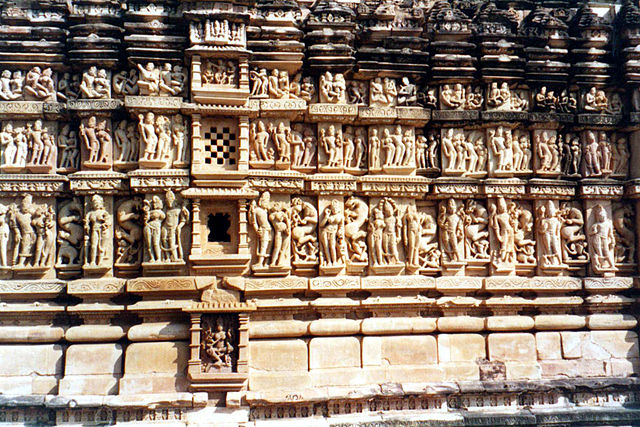
South Wall, Parshvanatha Temple
Jain complex, Khajuraho

|
South Wall, Parshvanatha TempleJain complex, Khajuraho |
This Chandella-period (mid-tenth century) Jain temple is dedicated to the 23d tirthankara (savior)
Parshvanath, the predecessor of Mahavira. The wall sculpture contains much Hindu, as well as Jain, imagery. It is sometimes suggested that the temple was originally Hindu and subsequently donated to the Jains, but actually the Jain religion by Chandella times had incorporated a great deal of Hindu iconography and practice.
Jain religion was codified by the 24th tirthankara, Mahavira (599-527 BC), a slightly older contemporary of the Buddha. Both Jainism and Buddhism originated as reactions to the orthodox Brahminism of their time.
All three religions share the fundamental belief in karma, that a person's situation in present life is the result of good or bad deeds accumulated in previous lives. Jainism and Buddhism differ from Hinduism in rejecting priestly ritual and distinctions of caste. However, unlike the Buddha's Middle Way, Jainism considers extreme asceticism to be the road to salvation - the accepted way for a Jain monk to end his life is to starve himself to death.
Jains believe that everything - animals, insects, even plants and inanimate material - has a soul (jiva). The soul is a small particle of pure light, which is obscured by the dark particles of matter surrounding it (this is a very old idea which dates back at least to the Zoroastrians of Persia in the first millennium BC). The aim of Jainist purification is to remove obscuring gross matter in order to liberate the soul within. Jains accept many dietary and behavioral restrictions in order to avoid harming the multitude of souls. For example, they wear gauze masks so as not to breathe in small insects, and will not eat root vegetables such as garlic and onions, since pulling up the root destroys the plant. Indeed, Jains cannot be farmers, since farming involves harm to plants (weeding and harvesting), insects (destroying insects and other vermin that threaten the crop), and the multitude of small animals that live in the soil (ploughing). Because mercantile occupations offer the least chance of direct harm to plants and animals, Jain laymen tend to make their living as traders, merchants, and shopkeepers. Of course, they still must eat the food that farmers provide.

|

|